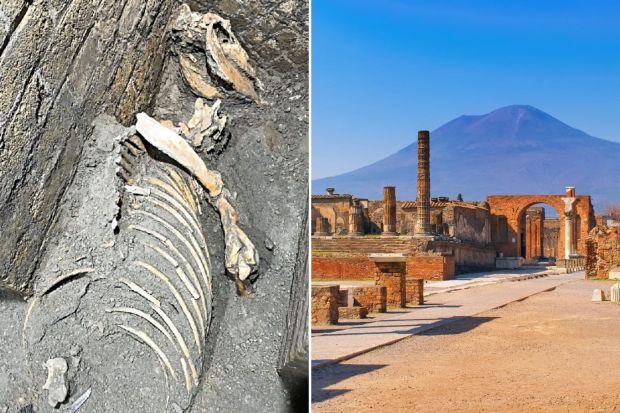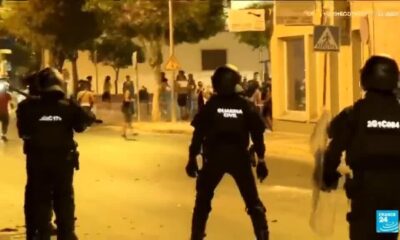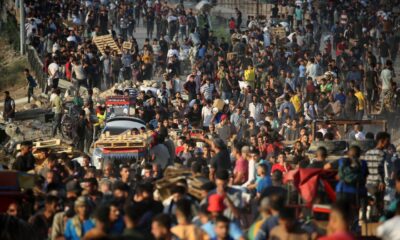Science
New Evidence Reveals Romans Returned to Life in Pompeii

Recent archaeological discoveries in Pompeii have unveiled compelling evidence that Romans returned to the city following the catastrophic eruption of Mount Vesuvius nearly two millennia ago. The eruption, which occurred in 79 AD, devastated the area, burying Pompeii under layers of volcanic ash and killing thousands of its inhabitants. Until now, the prevailing belief was that the survivors fled the ruins for good.
Excavations led by the Pompeii Archaeological Park have revealed that some of the poorest residents, unable to relocate elsewhere, returned to the city. These individuals sought to retrieve lost belongings among the debris. Evidence suggests that while the ground floors of many structures were transformed into cellars with ovens and mills, life resumed in the upper floors of the surviving buildings.
Gabriel Zuchtriegel, the site director, commented on the findings, noting, “Thanks to the new excavations, the picture is now clearer: post-79 Pompeii reemerges, less as a city than as a precarious and grey agglomeration, a kind of camp, a favela among the still-recognizable ruins of the Pompeii that once was.”
Historians and archaeologists have long speculated about the possibility of reoccupation, but substantial evidence was lacking. Previous excavation efforts often focused on the city’s remarkable frescoes and well-preserved homes, inadvertently overlooking signs of later habitation. As Zuchtriegel pointed out, the faint traces of reoccupation were sometimes removed without proper documentation.
According to estimates, the death toll in Pompeii may have reached between 15 and 20 percent of the city’s population, primarily due to the thermal shock from the eruption’s intense heat and toxic gases. The city remained largely abandoned and transformed into an informal settlement until at least the 5th century.
Pompeii, located near modern-day Naples in the Campania region of Italy, was renowned for its vibrant culture before the eruption. The destruction caused by Mount Vesuvius also obliterated the nearby town of Herculaneum and numerous villas in the vicinity. The eruption released thermal energy estimated to be a hundred thousand times greater than that of the atomic bombings in Hiroshima and Nagasaki.
The volcanic ash preserved the remains of Pompeii for centuries, allowing archaeologists to uncover the site in the late 16th century and conduct further excavations in subsequent years. Notably, plaster was injected into voids left by decomposed bodies, enabling researchers to recreate the exact poses of victims during the eruption.
Mount Vesuvius is recognized as one of the world’s most dangerous volcanoes. After a period of inactivity, it erupted violently, resulting in the destruction of Pompeii. The volcano has since erupted approximately three dozen times, with the last significant eruption occurring in 1944. Despite its current dormant status, experts classify Vesuvius as an “extremely active” volcano, posing risks to the millions of people residing nearby.
In February 2023, excavations at Pompeii’s thermal baths uncovered the skeleton of a child who perished during the eruption, further illustrating the human toll of this historic disaster. As research continues, more insights into life in Pompeii before and after the eruption will likely emerge, enriching our understanding of this ancient city.
-

 Entertainment1 week ago
Entertainment1 week agoAimee Osbourne Joins Family for Emotional Tribute to Ozzy
-

 Politics2 weeks ago
Politics2 weeks agoDanny Healy-Rae Considers Complaint After Altercation with Garda
-

 Top Stories3 weeks ago
Top Stories3 weeks agoFianna Fáil TDs Urgently Consider Maire Geoghegan-Quinn for Presidency
-

 World3 weeks ago
World3 weeks agoHawaii Commemorates 80 Years Since Hiroshima Bombing with Ceremony
-

 World3 weeks ago
World3 weeks agoGaza Aid Distribution Tragedy: 20 Killed Amid Ongoing Violence
-

 World3 weeks ago
World3 weeks agoCouple Convicted of Murdering Two-Year-Old Grandson in Wales
-

 Top Stories3 weeks ago
Top Stories3 weeks agoClashes Erupt Between Far-Right Groups and Migrants in Spain
-

 World3 weeks ago
World3 weeks agoAristocrat Constance Marten and Partner Convicted of Infant Murder
-

 Top Stories3 weeks ago
Top Stories3 weeks agoHistoric Dalkey Pub The Queens Reopens Under New Management
-

 World3 weeks ago
World3 weeks agoTrump Defends FBI Deputy Director Amid Epstein Files Controversy
-

 Business3 weeks ago
Business3 weeks agoSunshine 106.8 Boosts Irish Music After Regulator’s Request
-

 Politics3 weeks ago
Politics3 weeks agoTragic Crowd Surge at Gaza Aid Center Claims 20 Lives









